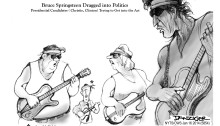Beacon-KWMU merger: Journalism re-imagined
BY JAN SCHAFFER / When the St. Louis Beacon and St. Louis Public Radio cinched their deal to merge their two newsrooms in December, they stepped right into the front lines of how old and new media are re-imagining journalism. The combined news organization (http://news.stlpublicradio.org), which will have a hefty three dozen-plus editorial employees, promises not only to alter the nature of journalism in St. Louis, but it also will chart new pathways for media entrepreneurs around the country exploring ways to make their startups sustainable.

